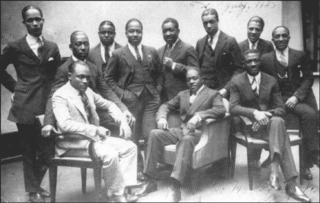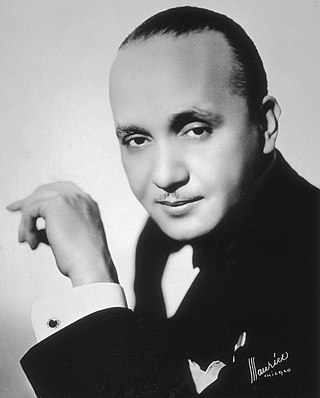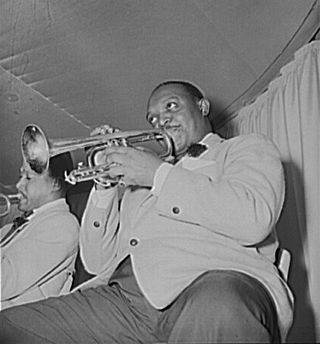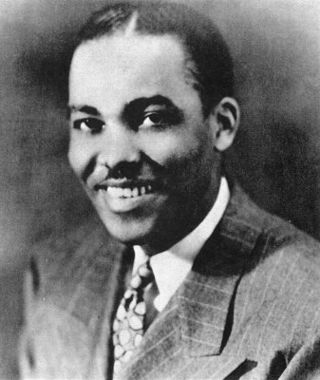
Louis Daniel Armstrong, nicknamed "Satchmo", "Satch", and "Pops", was an American trumpeter and vocalist. He was among the most influential figures in jazz. His career spanned five decades and several eras in the history of jazz. Armstrong received numerous accolades including the Grammy Award for Best Male Vocal Performance for Hello, Dolly! in 1965, as well as a posthumous win for the Grammy Lifetime Achievement Award in 1972. His influence crossed musical genres, with inductions into the DownBeat Jazz Hall of Fame, the Rock and Roll Hall of Fame, and the National Rhythm & Blues Hall of Fame, among others.

Benjamin David Goodman was an American clarinetist and bandleader, known as the "King of Swing".

Thomas James Ladnier was an American jazz trumpeter. Hugues Panassié – an influential French critic, jazz historian, and renowned exponent of New Orleans jazz – rated Ladnier, sometime on or before 1956, second only to Louis Armstrong.

David Roy Eldridge, nicknamed "Little Jazz", was an American jazz trumpeter. His sophisticated use of harmony, including the use of tritone substitutions, his virtuosic solos exhibiting a departure from the dominant style of jazz trumpet innovator Louis Armstrong, and his strong impact on Dizzy Gillespie mark him as one of the most influential musicians of the swing era and a precursor of bebop.

James Fletcher Hamilton Henderson was an American pianist, bandleader, arranger and composer, important in the development of big band jazz and swing music. He was one of the most prolific black musical arrangers and, along with Duke Ellington, is considered one of the most influential arrangers and bandleaders in jazz history. Henderson's influence was vast. He helped bridge the gap between the Dixieland and the swing eras. He was often known as "Smack" Henderson.

The Jazz Age was a period in the 1920s and 1930s in which jazz music and dance styles gained worldwide popularity. The Jazz Age's cultural repercussions were primarily felt in the United States, the birthplace of jazz. Originating in New Orleans as mainly sourced from the culture of African Americans, jazz played a significant part in wider cultural changes in this period, and its influence on popular culture continued long afterwards.

Andrew Hill was an American jazz pianist and composer.

Rex William Stewart Jr. was an American jazz cornetist who was a member of the Duke Ellington orchestra.

Adolphus Anthony Cheatham, better known as Doc Cheatham, was an American jazz trumpeter, singer, and bandleader. He is also the grandfather of musician Theo Croker.

William C. "Buster" Bailey was an American jazz clarinetist.
Augustus Aiken, better known as Gus Aiken and sometimes incorrectly spelled Gus Aitken, was an American jazz and blues trumpeter who had an active career from the 1910s through the 1960s. He was a prolific recording artist, beginning with some of the earliest recording made by Okeh Records. He made recordings with many well known jazz artists, among them Louis Armstrong, Sidney Bechet, Ethel Waters, and Mamie Smith.
Johnny Dunn was an American traditional jazz trumpeter and vaudeville performer, who was born in Memphis, Tennessee. He is probably best known for his work during the 1920s with musicians such as Perry Bradford or Noble Sissle. He has been compared in sound and style to both King Oliver and Louis Armstrong. In 1922, he recorded as a member of Mamie Smith's Jazz Hounds, together with Garvin Bushell, Coleman Hawkins, Everett Robbins, Bubber Miley and Herb Flemming.
Frederic Homer Johnson, known professionally as Keg Johnson, was an American jazz trombonist.

Joseph Copeland Garland was an American jazz saxophonist, composer, and arranger, best known for writing "In the Mood".
James Henry Harrison was an American jazz trombonist.
Charles Edward Dixon was an American jazz banjoist.
June Lawrence Cole was an American jazz bassist, tubist, and singer.

A Study in Frustration: The Fletcher Henderson Story is a box set compilation surveying studio recordings of the Fletcher Henderson Orchestra from 1923 to 1938, released in 1961 on Columbia Records, CXK 85470. It initially appeared as a four-album set produced by Frank Driggs and assembled by John Hammond, both of whom also wrote the liner notes. The set was part of a Thesaurus of Classic Jazz series on Columbia which included King of the Delta Blues Singers also worked on by Hammond and Driggs and released in 1961, the first album reissue of songs by blues legend Robert Johnson.
Prince Robinson was an American jazz reed player. He was known for soloing on both tenor saxophone and clarinet in the same recording.
Elmer "Tone" Williams was an American jazz tenor saxophonist,











